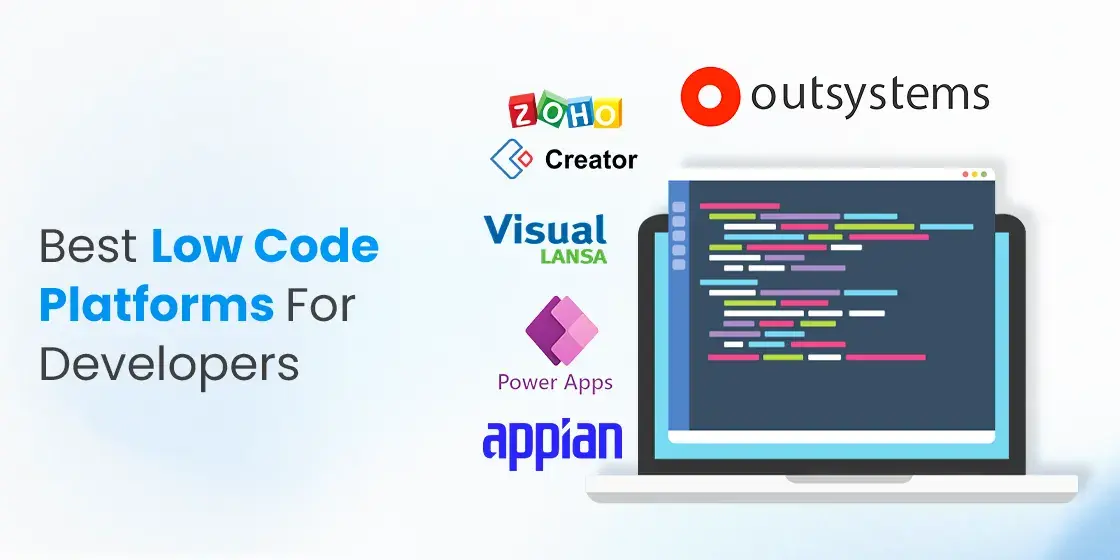Good Reasons To Choosing Low-Code Platform Sites
In Terms Of The Integration Capabilities, Low-Code Application Development Has A Lot Of Advantages.Low-code application integration offers many advantages, including the capability to seamlessly integrate different systems and services. Here are a few key advantages: Prebuilt Connectors and APIs
Connectors that are wide-ranging Low-code platforms have a vast collection of connectors that are pre-built for common enterprise systems (e.g. CRM, ERP databases cloud services, etc.). This makes it easier for connecting these systems.
API Integration: Many Low-Code platforms have out-of-box API integration features that let developers easily connect external services and data resources.
User-Friendliness:
Drag-and-Drop Integration: A variety of integration tasks can be completed by using drag-and-drop interfaces. This allows developers and nondevelopers to create complicated integrations with minimal or no programming.
Visual Workflow Builders: Tools to create workflows and data flow which visually represent help comprehend and setup integrations in a more intuitive manner.
Standardized Integration Methods:
SOAP/RESTful Service Support: Web services that use standard protocols, such as SOAP/REST, facilitate the integration of various different systems and applications.
OData Standards: OData standards permit the simple manipulation and accessibility of data across various platforms and apps.
Real-Time Data Synchronization:
Real-Time Integrations: Low code platforms can handle the real-time synchronization of data among systems, applications as well as databases. This will ensure that data is up-to-date and consistent across an company.
Event-Driven Architectural: Some platforms have event-driven architectural designs which allow applications to react in real-time, to events which are crucial for dynamic, interactive applications.
Legacy System Integration:
Interconnecting old Systems and new Systems Low-code platforms typically provide tools for integration with existing legacy systems. This allows organizations to modernize their IT Infrastructure without overhauling the existing systems.
Data Migration: Built-in tools help transfer data from old applications to new ones that are built on platforms that have low-code.
Third-Party Integration of Service:
Integration with Cloud Services: Seamless integration with cloud-based services like AWS, Azure, and Google Cloud allows for the ease of deployment and scaling applications.
Business Application Integration: Low-code platforms are able to connect to various business applications, such as Salesforce, SAP, Microsoft Dynamics, etc. This allows for a seamless workflow across different business functions.
Simple data management:
Unified Data Models Certain low-code platforms provide unified data models that simplify the management of data and integrate across various platforms.
Data connectors: These preconfigured data connectors give easy access and control to data from multiple sources.
Security and compliance:
Secure Integrations: Low-code platforms ensure that integrations adhere to security protocols and standards, helping to secure data both during transport and at rest.
Compliance Features: These platforms typically contain features that ensure integrations meet regulations (e.g., GDPR, HIPAA), providing security for companies handling sensitive data.
Extensibility:
Low-code platforms permit the creation of custom scripts and code to satisfy more complicated integration needs. The flexibility provided without compromising the ease of use.
Plug-in Ecosystems: A plug in ecosystem can be used to expand the capabilities of integration and permit users to expand the functionality when needed.
Low-code platforms are a powerful instrument to create interconnected robust and scalable applications. They are able to streamline the process for connecting different systems and improve the flow of data. Businesses can also leverage existing technologies and develop new ones while maintaining a cohesive IT environment. Take a look at the top rated Low-code Platform for application development examples for blog info including multiplatform mobile app development, develop mobile application, jdbc server, stored sql procedures, app modernisation, develop web app, paas service, rad application development, sso azure, app modernization and more.

The Benefits Of Low-Code Development In The Areas Of Governance And Security
Low-code app development provides several advantages in terms of governance and security. This is essential to ensure that applications conform to laws, are safe and well-managed throughout their life. Here are some of the key benefits.
Unified Management Console: Low-code applications typically provide a centralized management console where administrators can oversee and manage all the applications and ensure that they have a consistent management system across the company.
Role-Based Access Control RBAC: These platforms are equipped with powerful role-based controls that permit administrators to define access policies. It makes sure that only users with permission can alter or gain access to specific areas of the application.
Compliance and Regulatory Application:
Built-In Compliance Features: Many low-code applications are designed to comply with industry norms as well as regulations (e.g. GDPR, HIPAA). They offer frameworks and instruments to ensure that the applications are compliant with specifications.
Audit Trails and Logging Comprehensive logs and audit trails can be incorporated to allow companies to monitor changes in access, and monitor access and compliance.
New Security Measures to Improve Security
Data Encryption: Low-code platforms typically provide built-in encryption for data at rest and in transit, ensuring that data with sensitive information is secure.
Security Certifications: Many providers of low-code services have security certificates, such as ISO 27001 or SOC 2, which demonstrate that they adhere to high standards. These certificates offer an additional level of security to customers.
Automated security updates:
Regular Security Updates and Patches : Low-code platform handle automated security patches, updates and upgrades. Thus, applications are protected from current threats without developer intervention manually.
Security Monitoring - Continuous security monitoring is typically included. This provides real-time insights and alerts about possible security threats.
Data Governance
Data Access Policy: These systems help organizations define and enforce policies for access to data, while making certain that only authorized users have access to data and that the data is utilized in a safe manner.
Data Masking and Anonymization The built-in tools that mask and anonymize data help secure sensitive information in development and testing environments.
Consistent Application Management:
Pipelines for deployment and development Low-code platforms provide integrated development and deploy pipelines which include security inspections. They ensure security is maintained throughout the entire application lifecycle.
Version Control - Integrated version controls helps track changes to applications and allows them to be reverted when needed. They also maintain the integrity and quality of the software.
User Authentication & Authorization:
Single Sign On (SSO) Single Sign On (SSO): Single sign-on and other advanced authentication techniques reduces the burden of managing users and increases security.
Multi-Factor Authentication - Many platforms support multi-factor Authentication, which adds an extra layer to security when accessing apps.
Policy enforcement and Compliance Monitoring:
Policy Templates: Low-code platforms typically include pre-defined policy templates which help companies quickly implement security and governance policies.
Compliance Monitoring Tools - These tools provide constant monitoring of compliance status, and also provide reports, making it simple to identify and resolve potential issues.
Integration with Existing Security Infrastructure:
Easy integration: Low-code systems can be easily integrated with existing security tools and devices like firewalls, SIEM products (Security Information and Event Management), and identity management systems.
API Security: API features that protect data and maintain application integrity are built into the API.
Training and best practices:
Guided best practices: Many platforms include guidelines and recommended methods for developing secure applications. They help non-developers comply with security requirements.
Some low-code providers provide security training to help users build and maintain secure apps.
Low-code development can provide a range of security and governance benefits that ensure applications are developed and managed in an efficient safe and secure manner. These platforms contain the frameworks and tools needed to manage and oversee the process of developing applications, and safeguarding sensitive information while ensuring the compliance of regulations and enforcing rules. Check out the top rated https://www.wavemaker.com/low-code-enterprise-application-development-platform/ for site tips including azure sql, azure sql, cloud software applications, driver jdbc, app modernisation, azure sql databases, cross platform mobile development, application development platforms, application development platforms, cloud software applications and more.

The Benefits Of Developing Applications Using Low-Code In Workflow And Collaboration
The low-code approach to application development provides numerous advantages in terms of workflow and collaboration that make it a great option for businesses looking to improve team productivity and streamlining their process of development. Here are the top advantages: Improved Cross-Functional Collaboration:
Unified Development Environment. Low-code platforms allow all team members to collaborate in a single, unified environment. This includes developers, business analyst designers, stakeholder. This reduces silos and promotes greater communication.
Visual Development Tools: The graphic, drag-and-drop nature of low-code tools makes it simpler for non-technical team members be involved in the development process and ensure that the requirements of the business are correctly identified and implemented.
Communication Enhancement
Real-Time Collaboration: Many low-code platforms offer real-time collaboration capabilities like simultaneous editing, commenting, and instant feedback, which facilitate continuous communication and reduce the time spent on back-and-forth discussions.
Workspaces shared by teams. Teams are able to collaborate on shared workspaces. There, they are able to view, edit and talk about various project components.
Streamlined workflow management:
Integrated Project Management Tools: A lot of low-code platforms have integrated tools for managing projects that help teams monitor and organize their projects for development. This includes assigning tasks, tracking progress, and managing deadlines.
Workflow Automation Automating repetitive tasks as well as workflows can reduce manual errors and effort and allow the team to concentrate on the strategic tasks while increasing efficiency.
Speedier iteration cycles:
Rapid Prototyping Low-Code platforms are perfect for rapid prototyping. Iterative development is also feasible and allows teams to test, develop and refine their software within shorter time. This allows feedback to be quickly integrated and changes made.
Support for agile development: Supporting agile methodologies allows teams to be continuously working in sprints. This makes it easier to adjust and provide small increments to capabilities.
Accessibility for those who are not developers
Citizens Development: Lowcode platforms allow users of business applications (citizen developers), to create, modify, and maintain applications without extensive code knowledge. This relieves IT and Development teams of burdens and gives them the ability to respond faster to the business demands.
Training and Onboarding. The intuitive tools and the extensive training materials help the new team members get acquainted, improving the overall level of collaboration.
Centralized documentation and knowledge sharing
Low-code platforms usually have features for creating, maintaining and storing documentation within their platforms. This lets all the project information to be centrally stored and accessible easily.
Knowledge Repositories Teams can build and maintain repositories of information that contain best practices templates, templates and reuseable elements, which facilitate the sharing of information and reducing the amount of duplicate information.
Consistency Standardization, Consistency and Standards:
Standardized Components - The use of pre-built, standardized components provides the sameness between applications. It makes it easier for the members of the team to understand different parts of a specific project and work on these components.
Governance and Compliance: Integrated within governance frameworks, the frameworks for governance ensure that all development is in line with the organization's standards and regulations, minimizing non-compliance risks and ensuring the applications are of high-quality standards.
Feedback and Improvement Loops
Integrated Feedback Mechanisms Low-code platforms usually have integrated feedback mechanisms, allowing users to provide easy feedback on applications, which can then be incorporated into the development process.
Continuous Improvement: The capability to quickly iterate and deploy modifications as a result of feedback ensures the constant improvement of software. They are aligned closely to the requirements of users as well as business goals.
Reporting and visualization:
Real-Time Analysis: Analytics and reporting tools built into the software provide real-time information on the progress of projects along with user interaction and performance. This allows for the use of data to make decisions.
Visual Workflow Mapping - Visual tools that visualize workflows and processes can help teams improve their workflow by identifying bottlenecks.
Low-code development of applications can be a very effective tool for collaboration and workflow. It connects disparate teams, improves communication, and helps automate processes. This creates a efficient, flexible and productive development environment, which leads to better-quality applications.
